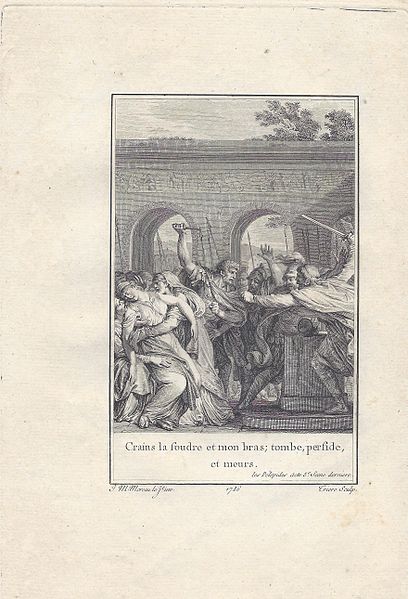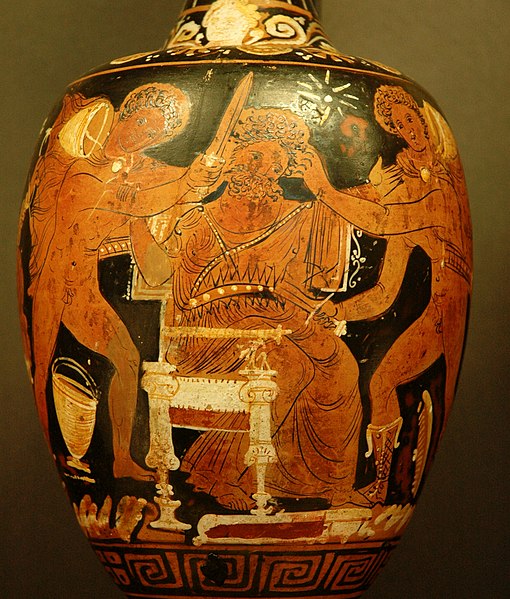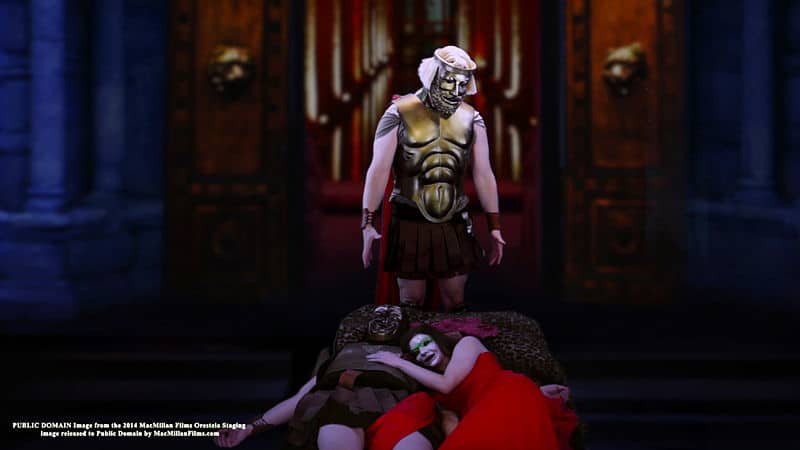Aegisthus might not be as renowned as Hercules or Achilles, The Mightiest Champion of The Trojan War, his tales however are equally captivating and essential in the grand tapestry of Greek mythology. Explore the intricate web of myths, relationships, and the legacy of this fascinating character.
Aegisthus Key Facts
| Parents | Thyestes and Pelops, The Once-eaten and Resurrected King |
| Partners | Clytemnestra, The Enigmatic Queen of Mycenaean Greece |
| Siblings | Many, due to Thyestes’ numerous children |
| Offspring | Erigone and Aletes |
| Other names | – |
| Roman name | – |
| Best Known Myth | Murder of Agamemnon, The Mighty King and Central Figure of the Trojan War |
Name and Etymology
The name “Aegisthus” doesn’t have a direct translation, but it’s believed to have roots in the Greek word “aigis,” meaning “goat-skin.” This might seem odd, but remember, in the ancient world, names often had practical or symbolic origins. The Roman counterpart of Aegisthus is not as distinct as, say, Zeus, The Supreme God and Jupiter; in fact, the Romans largely adopted his Greek tales without much alteration. Over time, Aegisthus has been known by this singular name, without the plethora of epithets that other figures in Greek mythology often possess.

Aegisthus’ Family and Relationships
Born into the tumultuous house of Atreus, Aegisthus’ lineage is a web of betrayals and vendettas. He was the offspring of Thyestes and his own daughter, Pelopia. This union, controversial and taboo, was a testament to the complex dynamics of the house they belonged to.
The house of Atreus was marked by a series of betrayals. Atreus and Thyestes, brothers and rivals, set the stage for the tragedies that would follow. In a notorious act of revenge, Atreus killed Thyestes’ sons, serving them to him at a feast. Aegisthus, however, narrowly escaped this gruesome fate, marking him as the sole survivor and heir to Thyestes’ line.
Aegisthus had several siblings, but due to the cruel act of Atreus, they met untimely ends. This left Aegisthus with a heavy burden, not just as the sole survivor but also as the one to carry forward his father’s legacy and grievances.
His connection to Agamemnon was not just adversarial; they were bound by blood. Agamemnon was the grandson of Atreus, making him and Aegisthus distant relatives. This familial tie added layers of complexity to their eventual confrontation.
Outside of these blood ties, Aegisthus’ most notable relationship was with Clytemnestra, Agamemnon’s wife. Their bond was forged not just out of love but also shared ambitions and grievances against Agamemnon. Together, they plotted and executed the murder of Agamemnon upon his return from the Trojan War. From this union, two children were born: Erigone and Aletes, further intertwining the destinies of the house of Atreus.
Myths about Aegisthus
Greek mythology is a vast tapestry of interconnected tales, and Aegisthus’ story is no exception. His life, filled with passion, betrayal, and revenge, is woven into some of the most captivating myths of ancient Greece.
Relationship with Clytemnestra
Before delving into the treacherous act that would define Aegisthus’ legacy, it’s essential to understand the bond he shared with Clytemnestra. Their relationship wasn’t a mere dalliance; it was a union forged in the fires of shared grievances. Clytemnestra, wife of Agamemnon, had her own reasons to despise her husband. Agamemnon had sacrificed their daughter, Iphigenia, to appease the goddess Artemis. This act, combined with Agamemnon’s affair with Briseis during the Trojan War, left Clytemnestra with a heart full of resentment.
Aegisthus, with his own set of grievances against Agamemnon, found a kindred spirit in Clytemnestra. Their bond was a potent mix of love, ambition, and revenge. Together, they plotted, schemed, and dreamt of a future where they could rule without the shadow of Agamemnon looming over them.
The Murder of Agamemnon
The culmination of Aegisthus and Clytemnestra’s shared ambitions was the treacherous murder of Agamemnon. Upon Agamemnon’s return from the Trojan War, he was greeted not with the joyous celebrations of a victorious king but with a deadly trap. Aegisthus, with Clytemnestra by his side, executed a plan they had been brewing for years.
Using a ruse, Clytemnestra drew Agamemnon into a vulnerable position. Once he was ensnared, Aegisthus struck, ending the life of the king and avenging the wrongs done to his father, Thyestes. This act wasn’t just about power; it was a deeply personal vendetta, a settling of old scores that had plagued the house of Atreus for generations.
The Downfall of Aegisthus
But as is often the case in Greek myths, actions have consequences. Aegisthus and Clytemnestra’s reign over Mycenae, though marked by power and influence, was always under the shadow of their treacherous act. Their rule lasted for seven years, but the seeds of their downfall had already been sown.
Orestes, son of Agamemnon, was away when his father was murdered. But upon his return, fueled by a desire for vengeance and justice, he sought to reclaim his rightful place. With the guidance of his sister Electra and the support of loyalists, Orestes confronted Aegisthus and Clytemnestra. In a tragic turn of events, Orestes killed them both, avenging his father’s death and bringing an end to Aegisthus’ ambitions and life. The cycle of revenge, which had plagued their family for so long, had come full circle.
Depiction And Characteristics
Aegisthus is often portrayed as a cunning and ambitious man, characteristics that played a pivotal role in his actions. His appearance isn’t as standardized as some other Greek figures; however, he’s often shown as a bearded man, sometimes holding a sword or dagger – symbols of his treacherous act against Agamemnon. His personality, as gleaned from myths, paints a picture of a man driven by revenge and ambition, yet also deeply influenced by love and partnership.
Symbols directly associated with Aegisthus are scarce, but the dagger or sword, representing his role in Agamemnon’s murder, is the most notable. No specific animals or plants are tied to him, unlike other Greek figures.
Representations Of Aegisthus In Art
Aegisthus, being a pivotal character in the tale of Agamemnon’s murder, has been depicted in various art forms throughout history. Ancient Greek pottery often showcases the moment of Agamemnon’s murder, with Aegisthus playing a central role. In sculptures, he’s sometimes seen whispering into Clytemnestra’s ear, plotting their next move.
One of the most famous depictions is in the “Oresteia” by Aeschylus, a trilogy of Greek tragedies. Here, Aegisthus’ character is explored in depth, from his motivations to his eventual downfall.

Mentions in Ancient Texts
Aegisthus, with his intricate ties to some of the most pivotal events in Greek mythology, has been immortalized in various ancient texts. These works, penned by legendary authors, offer a glimpse into his character, motivations, and the world he inhabited.
The “Oresteia” by Aeschylus
Written in the 5th century BC, the “Oresteia” is a trilogy of Greek tragedies that delves deep into the house of Atreus and its cursed lineage. Aeschylus, the playwright, is often regarded as the father of tragedy and was one of the great Athenian playwrights. His works are known for their deep philosophical undertones and exploration of justice and morality. In the “Oresteia,” Aegisthus’ character is explored in depth, from his motivations to his eventual downfall. A notable quote from the text reads: “For the male is by nature superior, and the female inferior; and the one rules, and the other is ruled.”
Homer’s “Odyssey” and “Iliad”
Penned around the 8th century BC, the “Odyssey” is an epic poem that chronicles the adventures of Odysseus as he tries to return home from the Trojan War. Homer, the legendary poet, is often considered the greatest of ancient Greek epic poets. His works have shaped Western literature and offer profound insights into human nature and society. In the “Odyssey,” Aegisthus’ treachery is recounted as a cautionary tale, warning of the consequences of going against the will of the gods.
The “Iliad,” also written around the 8th century BC, is an epic that primarily focuses on the events during the final year of the Trojan War. While the main narrative revolves around the conflict between Achilles and Agamemnon, the broader tapestry of the poem touches upon various characters and backstories, providing context to the world of ancient Greece. Homer, the revered poet behind both the “Iliad” and the “Odyssey,” masterfully weaves tales of heroism, honor, and the whims of gods.
In the “Iliad,” Aegisthus’ treachery is alluded to, particularly in the context of Agamemnon’s fate. The poem serves as a precursor to the events detailed in the “Odyssey,” setting the stage for Agamemnon’s tragic return home. Aegisthus’ role, though not central to the “Iliad,” is crucial in understanding the backdrop against which the Trojan War unfolds. A quote from the “Iliad” referencing Aegisthus goes: “Of all mankind, was he then doomed to be most wretched, who of old reigned as king in Mycenae, rich in gold?” This line, while not directly naming Aegisthus, alludes to the treachery that awaited Agamemnon upon his return.
“Electra” by Sophocles
Sophocles, another towering figure from ancient Greece, wrote “Electra” in the 5th century BC. Known for introducing a third actor and reducing the importance of the chorus in plays, Sophocles transformed the structure of drama. “Electra” focuses on the aftermath of Agamemnon’s murder, particularly on his daughter Electra’s thirst for revenge. Aegisthus’ role in the narrative is pivotal, as he stands as the primary antagonist, representing the treachery that has befallen the house of Atreus.
“Histories” by Herodotus
Herodotus, often dubbed the “Father of History,” wrote “Histories” in the 5th century BC. This work is an account of the Greco-Persian Wars, but it also delves into various myths, cultures, and events of the ancient world. While Aegisthus isn’t a central figure in “Histories,” Herodotus does touch upon the house of Atreus and the intricate web of betrayals and revenges that marked its history. Through Herodotus, we get a historian’s perspective on the tales, grounding them in the broader context of the ancient world.
Frequently Asked Questions
Aegisthus was the son of Thyestes and Pelopia.
He, along with Clytemnestra, plotted and executed the murder of Agamemnon, allowing him to rule Mycenae.
They shared a romantic and strategic bond, united in their grievances against Agamemnon.
He was killed by Orestes, Agamemnon’s son, as revenge for his father’s murder.
Aegisthus was a mortal, known more for his deeds and tales than any divine attributes.
Aegisthus played a key role in the aftermath of the Trojan War, particularly in the events surrounding Agamemnon’s return.
Featured Image Credit: JamesMacMillan, Public domain, via Wikimedia Commons

